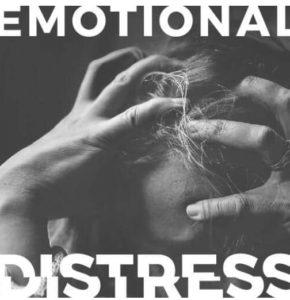
After an accident, people often expect to experience some aches and pains, so having to go to the doctor isn’t a surprise. But many accident victims do not expect the emotional distress that can follow a collision. When the dust settles, you may have lost your vehicle, or perhaps are unable to work due to your injuries. Suddenly, your entire life changes.
Perhaps you are now scared to drive, or you can’t get the disturbing scene of the accident out of your head. You begin to be irritable for no reason and can’t fall asleep at night. Unable to understand why you’re feeling this way, you find yourself asking “What are signs of emotional distress?”
Emotional trauma is very common following an accident. Many people are surprised to find how the emotional aspects of a collision affect them, and few people realize that these negative consequences can be a part of your personal injury claim. Read on to learn everything you need to know about recovering compensation for emotional distress following an automobile accident.
What Is Emotional Distress in Legal Terms?
So, what is emotional distress and how is this term different from the regular emotions people experience daily? In a legal context, emotional distress encompasses the negative mental consequences a person experiences after an accident. This can include pain from your injuries, anxiety related to driving or dealing with problems related to the accident, and many other symptoms.
While the law may make minor distinctions between pain and suffering, mental anguish, and mental injuries, all these effects can be loosely grouped together as emotional distress.
They are all a part of your non-economic damages suffered in a crash. These are intangible losses you experienced that may not have a direct monetary value but decreased your quality of life, even if only for a short while. You would not have endured these damages if the other driver had not caused the crash, so the damages are recoverable through an insurance claim or personal injury suit.

For a free legal consultation, call 800-537-8185
What Are the 5 Signs of Emotional Suffering?
Emotional distress can present itself in an infinite number of ways depending on each person. Five of the most common symptoms of emotional distress include:
- Anxiety
- Inability sleep
- Panic attacks
- Headaches
- Irritability
If you experience any of these symptoms following an accident, or if your usual mental health concerns increase significantly, you should mention it to your doctor. This could be your regular practitioner, a counselor or therapist you see, or the doctor treating your accident injuries. It is important to have the documentation in your medical records in case the insurer or at-fault driver challenges your claim for these damages.
Can You Sue for Emotional Distress?
Laws vary from state to state, but no matter where you are, the law will allow you to recover in some way for your emotional suffering. In auto accident cases, emotional distress makes up part of your personal injury claim, in addition to physical injuries.
Because emotional distress is more difficult to identify and diagnose, suing for emotional distress will require an accident victim to prove several things. Here’s a shortlist on what to expect to prove in an emotional distress claim:
1. Duration of Emotional Distress
The amount of time you have suffered from emotional distress is important if you decide to sue for mental anguish. You cannot make a claim for emotional distress if your suffering is only contemporaneous with the accident. Fear or nervousness at the time of an accident or immediately after is one thing, but if you are experiencing symptoms for a period of time after the accident, this could be considered emotional distress.
2. Severity of Your Symptoms
In addition to the length of time you have suffered from emotional distress, the severity of your symptoms is just as important. If your emotional distress is manifesting itself through physical symptoms, this can be an important factor in proving your claim.
3. Severity of the Accident
The severity of the accident is another factor that is taken into consideration. Severe accidents are more likely to cause emotional distress than a fender bender.
4. Who Is at Fault?
Whether the symptoms are a result of someone else’s negligence will also factor in. Are your symptoms actually the fault of the adverse party? If they occurred because of the crash, and that party caused the crash, then the answer is “yes.” This is something that must be determined and documented if you are trying to get a recovery for emotional distress.
5. Health Care Professional Testimonies
One of the most important ways to prove emotional distress is through testimony or evidence from a doctor or another health care professional. Not only that but showing that you received treatment because of this distress is also strong evidence for your case. Do not hesitate to discuss your mental and emotional health with your doctor or see a therapist if necessary to receive support for your symptoms. This could help you get better faster and also document your symptoms for your claim.
Click to contact our personal injury lawyers today
How Is Emotional Distress Different from IIED and NIED?
Emotional distress after an accident is usually claimed in connection with a physical injury, whereas intentional infliction of emotional distress (IIED) and negligent infliction of emotional distress are separate claims a person makes when he or she is not physically injured by the liable party. These claims have specific proof requirements depending on the circumstances and usually require extremely egregious conduct. This can be difficult to prove.
With a claim for non-economic damages such as pain and suffering or mental anguish, your attorney will use industry norms to determine a possible value and then seek compensation as a part of your well-rounded personal injury suit or insurance claim. There are no specific proof requirements—they just have to prove to the insurance company or judge and jury you deserve the compensation.
Have You or Someone You Love Been Injured in an Accident?
If you were injured in an accident, contact us for a free case evaluation. We will work with you on a contingency-fee-basis to gather this evidence and prove your case. If you are wondering whether you could file an emotional distress lawsuit, these laws vary from state to state so it is important you understand your rights. You may be eligible to file a claim for medical costs, emotional distress, and further damages.
A personal injury lawyer will meet with you to help you better understand your rights and options and explain how the process works. However, you only have a limited time to file your claim and negotiate a settlement or sue the at-fault driver and begin the process to take the case to trial. This varies by state but could be as little as one year from the accident date. Examples include:
- Two years in Alabama under Ala. Code § 6-2-38
- Three years in Arkansas per Ark. Code Ann. § 16-56-105
- One year in Louisiana under La. Civ. Code Art. 3492
- Three years in Mississippi per Miss. Code Ann. § 15-1-49
As soon as your physical injuries are stable, reach out to an attorney to discuss your next steps. Your law firm will ensure you meet the applicable statute of limitations as long as they know about your case and are representing you early enough to do so.
Talk to a Personal Injury Lawyer About Your Claim for Free Today
Fill out our free case evaluation form to see if you are eligible for a claim. An accident attorney at the Morris Bart law firm will assist you in the evaluation process. We can answer your questions, assess your rights, and discuss the strength of your case with you. Initial consultations are free. We have office locations throughout Louisiana, Mississippi, Alabama, and Arkansas.
Call us at 1-800-537-8185 today to connect with an attorney near you.
Questions?Call 800-537-8185
to find a Morris Bart office near you.





